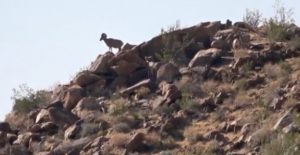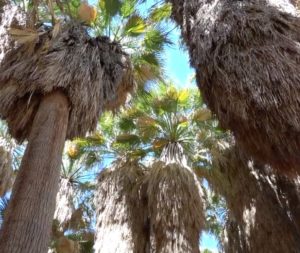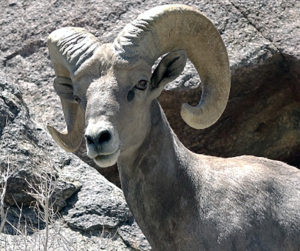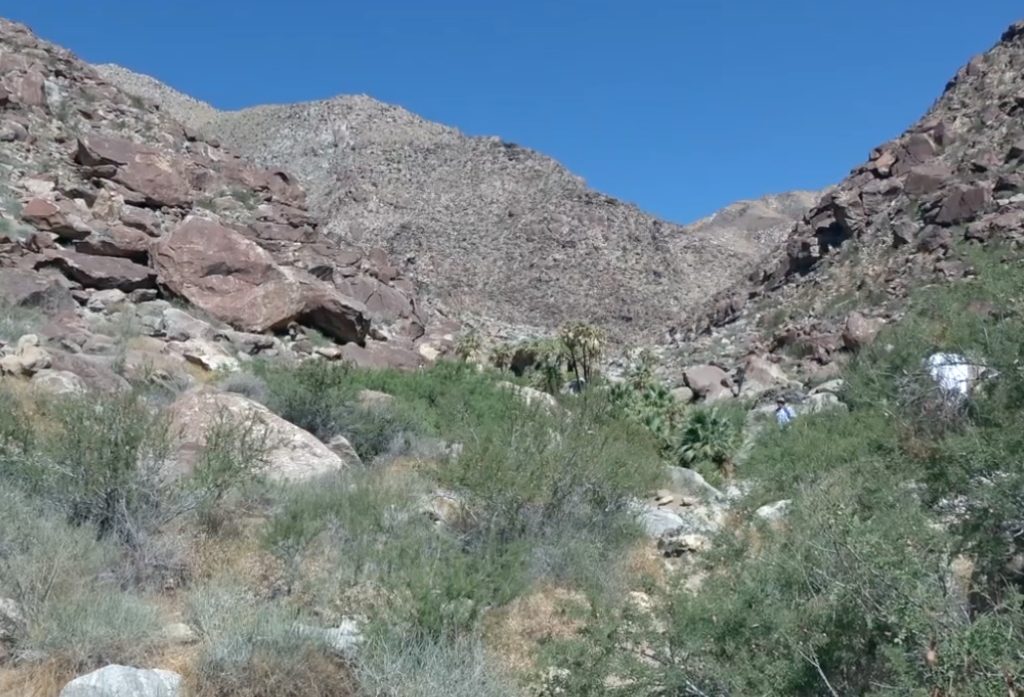(Sorry, sometimes I can’t help myself.) Over several years, in all the times I’d visited Anza-Borrego Desert State Park, I had never seen the sheep for which the park is partly named (“lamb” in Spanish is borrego). I first saw a few sheep in March, from afar, as I posted then. In June, on my way home from a board meeting, I saw a ewe atop a crest in the park. Again, from afar.
On Sunday, I joined volunteers helping in the 44th annual Sheep Count at the park. Several dozen volunteers went out to 20 different sites in the park for 2 1/2 days to find and count sheep to help monitor the park’s herd of this endangered subspecies – the Peninsular Desert Bighorn Sheep. Many hiked out each morning to their site, but others backpacked out and stayed at their remote site from Thursday night to Sunday midday. Some sites required hikes of up to six hours to reach them.
The three volunteers I joined had hiked out in the park, observing sheep, on both the Friday and Saturday before, for 10 hours each day. I was the dilettante, coming in for the final day, and a half-day at that.
Our location was Borrego Palm Canyon, 1st Grove. The set of palm trees in the center, rear, is the first of three palm groves in the canyon. There were sheep-counters at the second and third groves as well, hours further into the canyon and with no trail.
It took about 45 minutes to hike into the canyon. I was glad that I had a guide with me, because, for periods of time, it was unclear to me where the “trail” was. I had never been out here, though it is the most popular trail in the park, because it is so “easy.” I had a rather naive notion of what an “easy” trail would be like. I was lugging a camp chair, camera equipment (including a tripod), a few containers of water, and more. As you’ll see in the video (of course there’s a video), the trail was at times not flat. (According to my iPhone, for the day, I walked 4.2 miles, taking 12,119 steps, and climbed 13 floors. For some of you, that approaches a normal day. For me, it was very much an outlier. It was in the 80s when we went in around 6:30 am and about 105 coming out midday.)
I was told there was no guarantee that I would see any sheep. Several groups of volunteers indeed reported no sightings for the entire weekend. But I hit the jackpot. Not only 15-18 sheep, but some quite close.
 The sheep didn’t start to appear until close to 8 am. The volunteers said they actually seemed to be late sleepers. We had seen hikers in the early morning draw a blank in terms of sheep sightings. Ewes, I was told, usually appeared first and rams followed. This screen capture profiles a solitary ewe near the top of the hillside, but there are several rams below her. I did not see the rams at the time and could discern them only when I watched the video. As you might expect, the sheep blend rather well into their environment.
The sheep didn’t start to appear until close to 8 am. The volunteers said they actually seemed to be late sleepers. We had seen hikers in the early morning draw a blank in terms of sheep sightings. Ewes, I was told, usually appeared first and rams followed. This screen capture profiles a solitary ewe near the top of the hillside, but there are several rams below her. I did not see the rams at the time and could discern them only when I watched the video. As you might expect, the sheep blend rather well into their environment.
In one instance, I could have been a YouTube hero . . . and a likely patient in the hospital, if I was lucky. Standing on the trail with another volunteer, we heard sounds from around a curve. My companion said, “Those are not human.” Suddenly, what were hoofsteps were quicker and louder and a ram charged around the corner of the trail, heading right at me. I can still see the headlights of that approaching train, but only in my mind’s eye. I lowered the video camera and jumped off the trail. The ram veered off as well.
Palm Canyon is much more “verdant” than in previous years, because of the above-average rainfall. Hard to imagine, but many of the boulders strewn about the canyon floor had been carried there by massive floods, from centuries, eons ago.
 The sheep drink out of rivulets of water that come down from the palm grove (inside view, at left). First Grove contains a pool of water, but the sheep avoid the grove as it provides cover for potential predators, i.e., mountain lions. The sheep seem rather oblivious to people. They are used to them in this canyon, because of its popularity. And there is the thought they realize mountain lions avoid humans, so it is better to be out and about when humans are as well.
The sheep drink out of rivulets of water that come down from the palm grove (inside view, at left). First Grove contains a pool of water, but the sheep avoid the grove as it provides cover for potential predators, i.e., mountain lions. The sheep seem rather oblivious to people. They are used to them in this canyon, because of its popularity. And there is the thought they realize mountain lions avoid humans, so it is better to be out and about when humans are as well.
This video is less formal than the one I prepared for the Anza-Borrego Foundation. That one contains a bit more on what the counters do and the scientific aspect of the project. I hope you enjoy this view of the sheep and their world. (I recommend watching on your device with the biggest screen, not a phone.)


